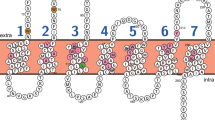Abstract
In diatoms, the siliceous cell walls are enveloped by an organic component which includes 4-hydroxyproline and 3,4-dihydroxy-L-proline. The formation of these two amino acids were studied in Nitzschia angularis in Si-starvation synchrony. Both appear to arise from peptidyl proline. Its conversion to peptidyl hydroxyproline was shown in cell-free extracts and in kinetic studies using [14C]proline. Two lines of evidence indicate that dihydroxyproline does not arise from the further hydroxylation of peptidyl hydroxyproline: First, there was a lag of several minutes between the incorporation of [14C]proline into protein and the appearance therein of [14C]hydroxyproline but no such lag for the appearance of dihydroxyproline. Second, α,α′-dipyridyl blocked the formation of hydroxyproline, but not of dihydroxypyroline, from peptidyl proline. Cell walls made in the presence of dipyridyl differed little in overall chemical composition from walls made in its absence and were morphologically identical. [14C]dehydroproline was rapidly metabolized in the cells, with [14C]dihydroxyproline a prominent product. Studies of the conversion of [14C]proline to [14C]hydroxyproline at various stages of wall formation showed an increased synthesis of [14C]dihydroxyproline at the end of cell separation.
Similar content being viewed by others
References
Coombs, J., Volcani, B.E.: Studies on the biochemistry and fine structure of silica shell formation in diatoms. Chemical changes in the wall of Navicula pelliculosa during its formation. Planta 82, 280–292 (1968)
Coombs, J., Halicki, P.J., Holm-Hansen, O., Volcani, B.E.: Studies on the biochemistry and fine structure of silica shell formation in diatoms. II. Changes in the concentratios of nucleoside triphosphates in silicon-starvation synchrony of Navicula pelliculosa. Exp. Cell Res. 47, 315–328 (1967a)
Coombs, J., Halicki, P.J., Holm-Hansen, O., Volcani, B.E.: Studies on the biochemistry and fine structure of silica shell formation in diatoms. Changes in concentration of nucleoside triphosphates during synchronized division of Cylindrotheca fusiformis Reimann and Lewin. Exp. Cell Res. 47, 302–314 (1967b)
Darley, W.M., Volcani, B.E.: Role of silicon in diatom metabolism. A silicon requirement for deoxyribonucleic acid synthesis in the diatom Cylindrotheca fusiformis Reimann and Lewin. Exp. Cell Res. 58, 334–342 (1969)
Darley, W.M., Volcani, B.E.: Synchronized cultures: diatoms. Meth. in Enzymol. 23, pt. A, 85–96 (1971)
Fowden, L., Lewis, D., Tristram, H.: Toxic amino acids: their action as antimetabolites. Adv. Enzymol. 29, 89–163 (1967)
Hayashi, O., Nozaki, M.: Nature and mechanisms of oxygenases. Science 164, 389–396 (1969)
Hecky, R.E., Mopper, K., Kilham, P., Degens, E.T.: The amino acid and sugar composition of diatom cell walls. Marine Biol. 19, 323–331 (1973)
Hurych, J., Chvapil, M.: Inhibition of collagen formation by chelating agents. Biochim. Biophys. Acta 97, 361–365 (1965)
Kates, M., Volcani, B.E.: Lipid components of diatoms. Biochim. Biophys. Acta 116, 264–278 (1966)
Kivirikko, K., Liesmaa, M.: Colorimetric determination of hydroxyproline. Scand. J. clin. Lab. Invest. 11, 128–133 (1959)
Lamport, D.T.A.: The role of hydroxyproline-rich proteins in the extracellular matrix of plants. In: Macromolecules regulating growth and development, pp. 113–130, Hay, E., King, T., Papaconstantinou, J., eds. New York: Academic Press 1974
Lamport, D.T.A., Miller, D.: Hydroxyproline arabinosides in the plant kingdom. Plant Physiol. 48, 454–456 (1971)
Lowry, O.H., Rosebrough, N.J., Farr, A.L., Randall, R.J.: Protein measurement with the Folin phenol reagent. J. Biol. Chem. 193, 265–275 (1951)
Nakajima, T., Volcani, B.E.: 3,4-Dihydroxyproline, a new amino acid from diatom cell walls. Science 164, 1400–1401 (1969)
Raimann, B.E.F., Lewin, J.C., Volcani, B.E.: Studies on the biochemistry and fine structure of silica shell formation in diatoms. I. The structure of the cell wall of Cylindrotheca fusiformis Reimann and Lewin. J. Cell Biol. 24, 39–55 (1965)
Rosenbloom, J., Prockop, D.J.: Biochemical aspects of collagen biosynthesis. In: Repair and regeneration: the scientific basis of medical practice, pp. 117–135, Dumphy, J.E., Van Winkle, W., eds. New York: McGraw-Hill 1968
Sadava, D., Chrispeels, M.J.: Peptidyl proline hydroxylase from plant cells. Biochim. Biophys. Acta 227, 278–287 (1971)
Tristram, H.: Some aspects of the regulation of amino acid biosynthesis in bacteria. In: Biosynthesis and its control in plants, pp. 22–27, Milborrow, B.V., ed. New York: Academic Press 1973
Author information
Authors and Affiliations
Rights and permissions
About this article
Cite this article
Sadava, D., Volcani, B.E. Studies on the biochemistry and fine structure of silica shell formation in diatoms. Planta 135, 7–11 (1977). https://doi.org/10.1007/BF00387968
Received:
Accepted:
Issue Date:
DOI: https://doi.org/10.1007/BF00387968




